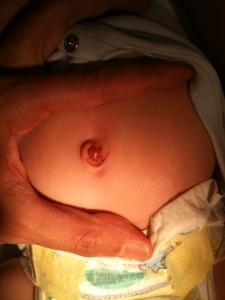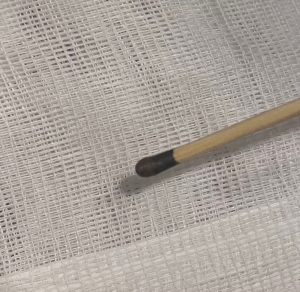Newborn’s umbilical cord…
February 2023
The baby is born. Many people are used to small children, babies. But in the first days, that wet, white-blue-colored extension hanging from the navel, the umbilical cord, can cause a lot of anxiety. I will tell you about the umbilical cord of a newborn baby through the glasses of a pediatric surgeon.
Earlier, I explained that a flat, 3-layered structure is formed in the first embryonic period. This flat, disc-shaped structure begins to curl in on itself when the embryo is about 1 month old, becoming a three-dimensional creature. When it is folded in, the abdominal region begins to close and a bond with a diameter of approximately 1.5 cm is formed between the mother and the baby. This ligament is the umbilical cord we know.
The digestive system and the urogenital system are formed from the structures that enter the abdomen with the inward bending of the fetus. In other words, our intestines, kidneys, bladder, genital organs… This means that there is a connection between the umbilical cord and the intestines and urinary tract. Over time, the connection with the intestines disappears. The connection with the bladder, that is, the urinary bladder, is also closed and becomes a fibrotic, closed rope. Only 2 arteries, 1 vein and the gel-like support structure surrounding them remain in the umbilical cord. Here we check the structures inside the umbilical cord in every newborn baby. For example, we note if there is 1 artery instead of 2 arteries. Or is the umbilical cord wider than normal, whether there are intestinal structures other than veins, or whether it is more finely checked.
If everything is as we want, we place the clamp.
If it is not what we want, I will explain what can happen in another video so that the video does not get boring, and the excitement does not end in a single video.
Since this cord is not used, usually within 1 week after birth, the vessels first become clogged, the blood in it coagulates and dries up, the cells we call phagocytes come and begin to eat the connection point, and then they fall. As I said, it decreases in an average of 1 week, but this process can take up to a few weeks.
How will we take care of the belly during the belly fall process?
First of all, where the baby was born is very important. If the baby was born outside the hospital in a place where hygienic conditions are not very suitable, it is absolutely necessary to care with an antiseptic containing chlorhexidine in order to prevent possible umbilical infection, namely omphalitis. We still hear that materials such as ash, manure and clay are used in very underdeveloped areas. Oh. They both increase the risk of infection and cause neonatal tetanus.
If the baby was born in a suitable environment, in a hospital, there is nothing to worry about. Drying is already a natural process. You do not need to use substances such as antiseptics or alcohol. There are dozens of studies showing that they do not provide an additional contribution and even prolong the drying process. So, it is enough to keep the umbilical cord of our baby born in the hospital dry. By curling the diaper, you can prevent the urine from touching by leaving the navel open, and you can dry it faster with the interaction of the air.
Eventually it will darken and fall. This separation process can take up to 3-4 weeks, but if it lasts longer, we may need to investigate the underlying immune system disorders, infection or the fact that some of the residues that I have told you about are not lost. For example, a type of disease in which the adhesion of leukocytes, that is, white blood cells, is impaired, can show itself with late umbilical cord separation and umbilical infection.
I will explain the subject of umbilical infection a little more in another journal.
Not everything is over when the belly cord falls of.
For example, parents are very afraid of a small amount of blood in the navel. However, a small amount of blood that does not overflow from the navel and contaminates the light baby’s clothes is not important at all. It dries up and goes away. If the amount increases slightly, or if it takes a long time to dry, it may be necessary to repeat the vitamin K vaccine.
After the cord is separated, normally the open surface is closed by the epithelium. None of us has an open belly button. Covered by normal skin. If the separation process takes a little longer, maybe a slight inflammation is added, if the skin that should cover the opening is a little late, the inflammation cells begin to accumulate on that opening. They overlap and form a small, pink, shiny texture. The wetness of this tissue can cause a yellowish stain on the baby’s clothes. We call this tissue “umbilical granuloma”. In the picture you can notice how the umbilical granuloma looks, wet and pink.

We destroy the small ones with silver nitrate.

Silver nitrate, as you can see in the photo, looks like such a long matchstick. Often one application is not enough, it may be necessary to repeat a few times. There are creams and salts used other than silver nitrate, but their safety and effectiveness are not yet clear.
If the granuloma is a little large and silver nitrate will not be enough, we immediately tie it up and remove it from the bottom in the outpatient clinic. The baby does not feel any pain either, as the overlapping inflammatory cells do not contain nerves.
If it does not go away with silver nitrate, if the discharge is more, if it is harder and larger than the granuloma tissue we are used to, polyps and other pathologies come to our minds. But I will tell you about them on the next cruise.
You know, if the cruise is long, it can cause nausea.
Stay happy.
Prof. Dr. Egemen Eroglu
January 2023



